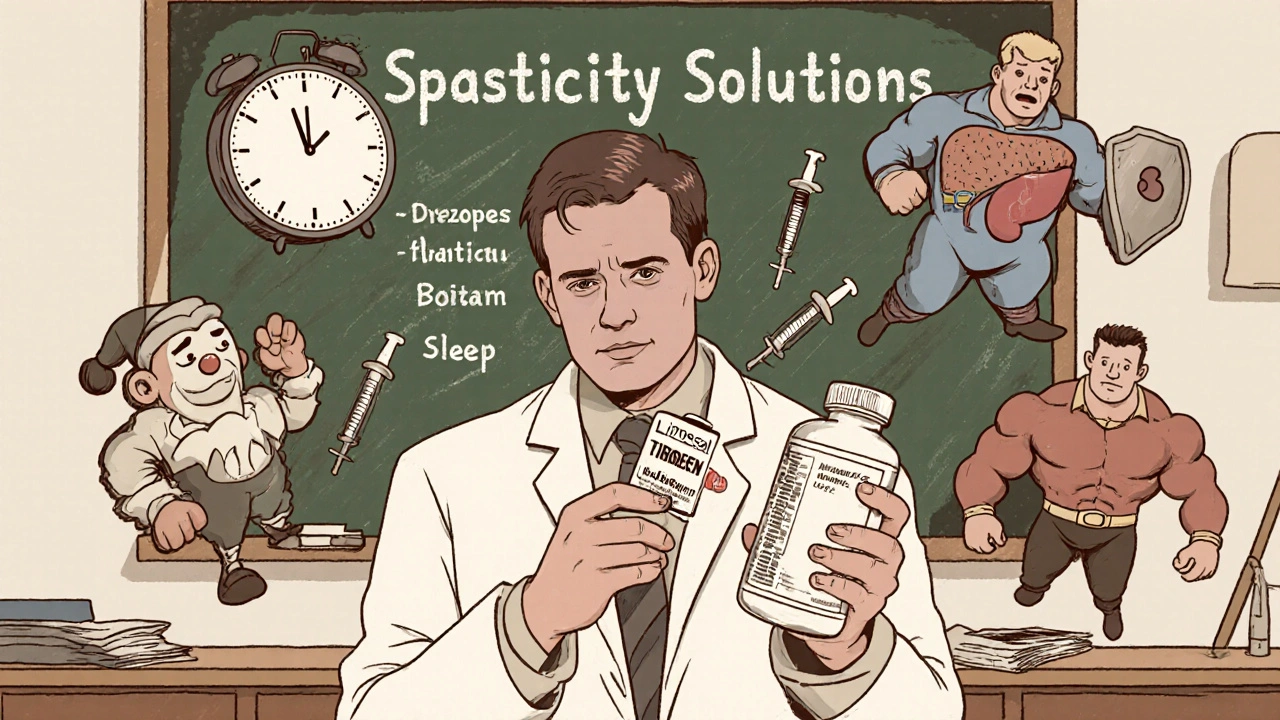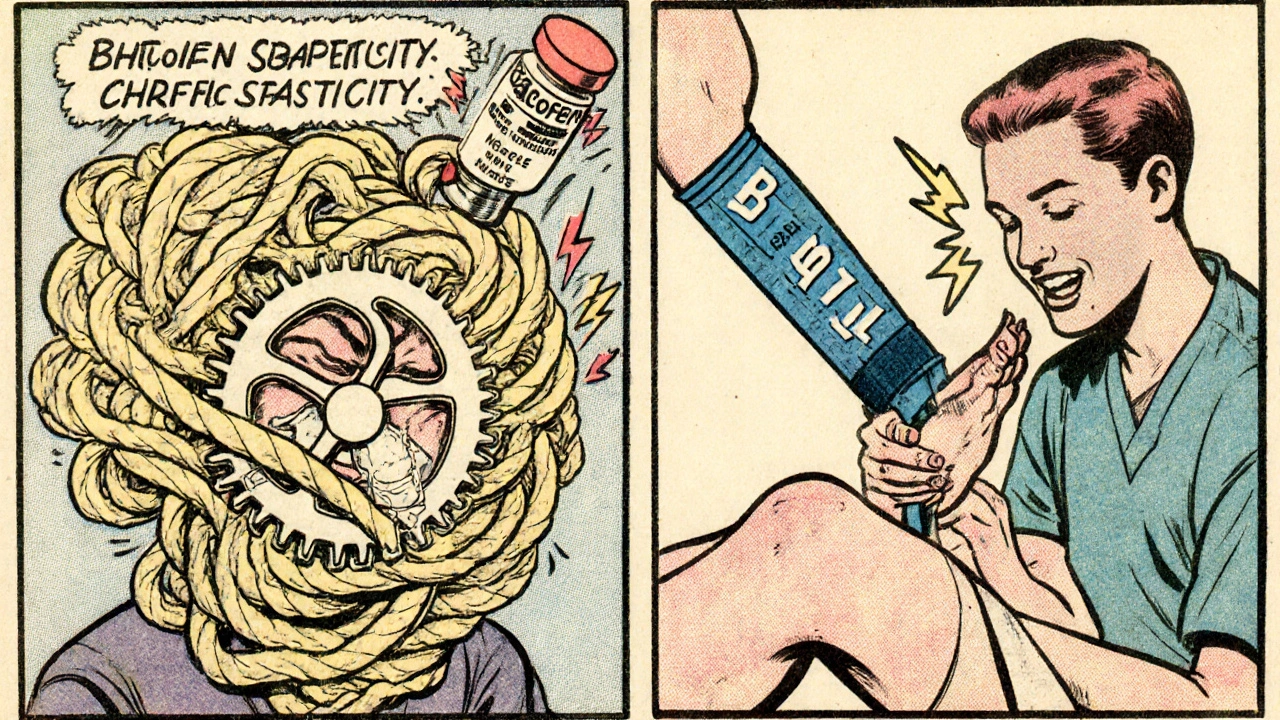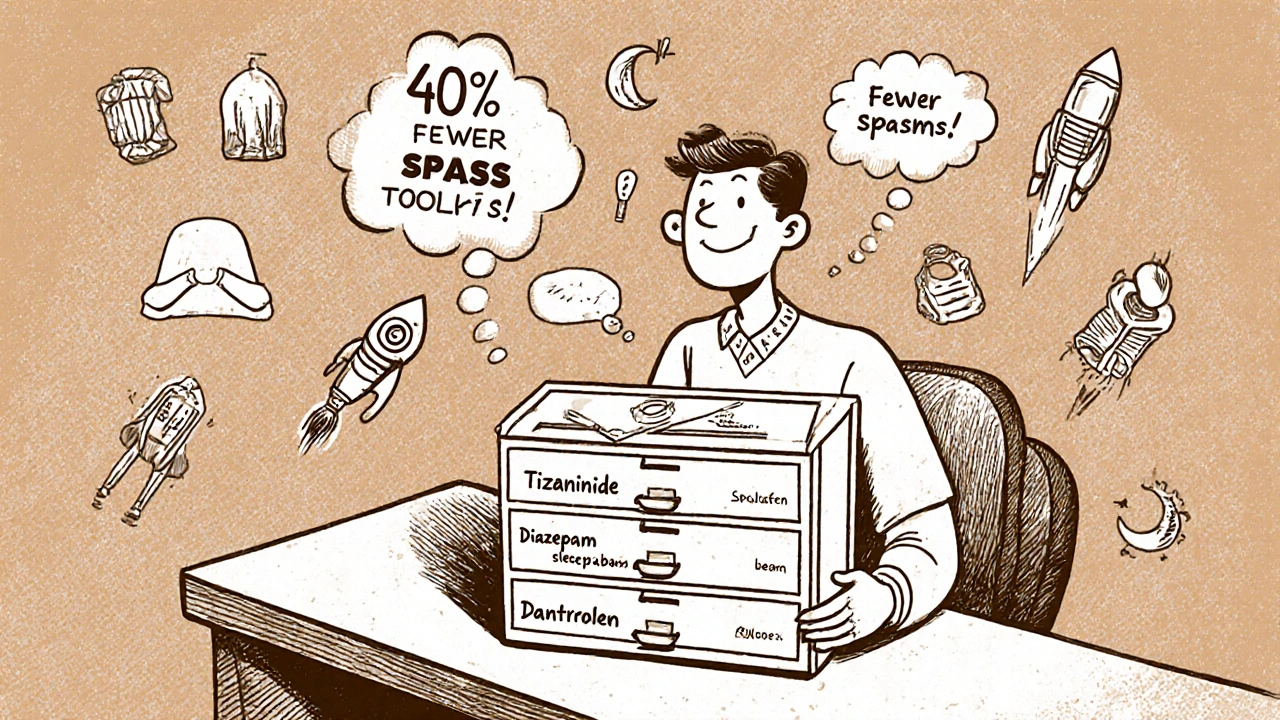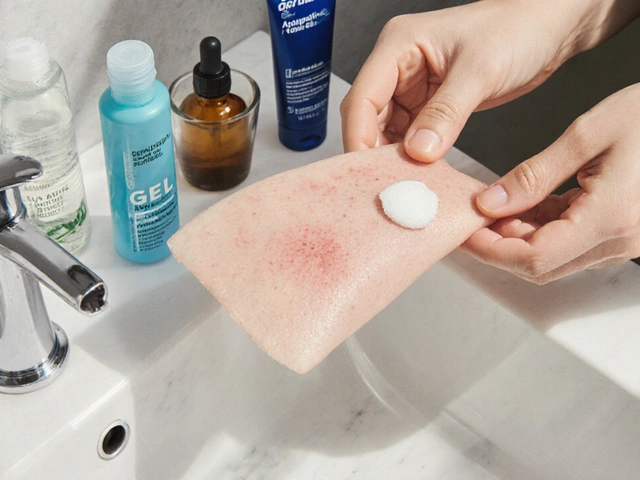Oct
28

- by Gareth Harington
- 1 Comments
Spasticity Treatment Selector
Find Your Best Muscle Relaxant Option
This tool helps you compare different muscle relaxants for spasticity based on your specific condition, symptoms, and priorities. Select your answers below to see which options might be most suitable for you.
Your Recommendations
Lioresal is the brand name for baclofen, a muscle relaxant used mainly to treat spasticity - the stiff, tight muscles caused by conditions like multiple sclerosis, spinal cord injuries, or cerebral palsy. If you're taking Lioresal and wondering if there are better or cheaper options, you're not alone. Many people on this medication look for alternatives due to side effects, cost, or lack of full symptom control. This guide breaks down the most common alternatives to Lioresal, how they stack up, and who might benefit from each one.
How Lioresal (Baclofen) Works
Lioresal works by acting on GABA-B receptors in the spinal cord and brain. This reduces the overactive nerve signals that cause muscles to tighten uncontrollably. It’s not a painkiller - it targets the root cause of muscle stiffness. Most people start with 5 mg three times a day and slowly increase until they find the right dose, often between 20-80 mg daily. Some need higher doses, but side effects like drowsiness, dizziness, or weakness can limit how much you can take.
It takes a few weeks to see full results, and stopping suddenly can cause withdrawal symptoms like hallucinations or seizures. That’s why you never quit Lioresal cold turkey - your doctor will taper you off slowly.
Alternative 1: Tizanidine (Zanaflex)
Tizanidine is one of the most common alternatives to Lioresal. Like baclofen, it’s used for spasticity from MS or spinal injuries. But it works differently - it’s an alpha-2 adrenergic agonist that reduces nerve signals from the brain to the muscles.
Here’s how they compare:
| Feature | Lioresal (Baclofen) | Tizanidine (Zanaflex) |
|---|---|---|
| Onset of Action | 1-2 hours | 1 hour |
| Duration | 4-6 hours | 3-5 hours |
| Common Side Effects | Drowsiness, dizziness, weakness | Drowsiness, dry mouth, low blood pressure |
| Best For | Chronic, persistent spasticity | Intermittent spasticity, nighttime use |
| Withdrawal Risk | High - must taper | Moderate - less severe than baclofen |
Tizanidine is often preferred if you need quick relief for sudden muscle spasms - especially before physical therapy or at night. But it doesn’t work as well for constant, all-day stiffness. Also, it can lower blood pressure, so people with heart conditions need to be careful.
Alternative 2: Diazepam (Valium)
Diazepam is a benzodiazepine - a class of drugs better known for treating anxiety and seizures. But it’s also used off-label for spasticity because it enhances GABA activity, similar to baclofen.
The big advantage? It’s cheap and available as a generic. The downside? It’s addictive. Long-term use can lead to dependence, memory problems, and falls in older adults. The CDC warns against using benzodiazepines for more than a few weeks in people over 65.
Doctors usually reserve diazepam for short-term use or when other options fail. It’s not ideal for daily, long-term spasticity control. But if someone has both spasticity and anxiety, it might be considered as a dual-purpose option - though only under strict supervision.
Alternative 3: Dantrolene (Dantrium)
Dantrolene works differently than the others. Instead of acting on nerves, it directly affects muscle cells by blocking calcium release. This stops muscles from contracting too hard.
It’s often used when other muscle relaxants don’t work - especially in people with cerebral palsy or after stroke. But it comes with serious risks: liver damage. The FDA requires regular liver function tests if you take dantrolene long-term.
Side effects include fatigue, diarrhea, and weakness. Because it’s not as targeted as baclofen or tizanidine, it can make you feel generally sluggish. Still, for some, it’s the only thing that gives real relief when nerve-targeting drugs fail.

Alternative 4: Botulinum Toxin Injections (Botox, Dysport)
If your spasticity is limited to one or two muscle groups - like a clenched fist, stiff ankle, or tight calf - injections might be the best choice.
Botox and Dysport are purified forms of botulinum toxin. When injected directly into the affected muscle, they block nerve signals locally. Effects last 3-6 months. You don’t need to take pills daily. No systemic side effects like drowsiness or dizziness.
It’s not a replacement for oral meds like Lioresal if you have widespread spasticity. But for focal problems - say, a foot that drags or a hand that won’t open - injections are often more effective and safer long-term. Many people use them alongside baclofen or tizanidine for better control.
Alternative 5: Cannabis-Based Medications (Sativex, Epidiolex)
In countries like Canada, the UK, and parts of Australia, cannabis-based treatments are approved for MS-related spasticity. Sativex (nabiximols) is a mouth spray containing THC and CBD. It’s been shown in clinical trials to reduce spasticity scores by 20-30% in people who didn’t respond to baclofen.
It’s not FDA-approved in the U.S., and in Australia, it’s only available through special access schemes. It’s expensive - over $1,000 per month without subsidy. But for those who’ve tried everything else, it can be life-changing. Side effects include dizziness, dry mouth, and mild euphoria.
It’s not a first-line option. But if you’ve been on Lioresal for years with little improvement, it’s worth discussing with a neurologist who specializes in spasticity.
Non-Drug Approaches That Work
Medications aren’t the only way to manage spasticity. Physical therapy, stretching, and orthotics (braces or splints) are often underused but highly effective. A 2023 study in the Journal of Neurorehabilitation found that people who combined baclofen with weekly physiotherapy had 40% fewer muscle spasms than those who took the drug alone.
Other tools:
- Electrical stimulation (NMES) to gently activate muscles and reduce tightness
- Serial casting to slowly stretch stiff joints
- Yoga or tai chi for flexibility and relaxation
- Heat therapy or massage for temporary relief
Many people stop trying these because they’re not “quick fixes.” But they’re safer, cheaper, and help you stay active - which itself reduces spasticity over time.

When to Consider Switching from Lioresal
You might want to switch if:
- You’re taking more than 80 mg/day and still having spasms
- You feel too drowsy to drive or work
- You’ve had withdrawal symptoms after missing a dose
- Cost is a barrier - brand Lioresal can cost $150/month in Australia without PBS subsidy
- Your spasticity is localized - injections might be better
Don’t switch on your own. Talk to your neurologist or GP. They can help you try one alternative at a time and monitor your progress.
What Most People Get Wrong
Many assume that if Lioresal doesn’t work, nothing will. That’s not true. Each drug works differently, and people respond unpredictably. One person might hate tizanidine but thrive on dantrolene. Another might get great results with Botox alone.
Also, people often stop meds too soon. It can take 6-8 weeks to see the full effect of baclofen or tizanidine. Don’t give up after two weeks.
And don’t assume generic baclofen is the same as brand Lioresal. While they’re chemically identical, some users report more side effects with certain generics - possibly due to fillers or absorption differences. If you switch brands and feel worse, tell your pharmacist.
Final Thoughts
Lioresal is a solid option for many, but it’s not the only one - or even the best for everyone. The right choice depends on your symptoms, lifestyle, other health conditions, and how your body reacts. Tizanidine for quick, targeted relief. Dantrolene for stubborn cases. Injections for localized tightness. Cannabis-based meds if other options fail and you have access.
Combining medication with physical therapy gives the best long-term results. And never stop any muscle relaxant suddenly - always taper under medical supervision.
If you’re still struggling with spasticity despite Lioresal, ask your doctor about trying one alternative. You might be surprised by how much better you feel.
Can I take Lioresal and tizanidine together?
It’s possible, but rarely recommended. Both drugs cause drowsiness and low blood pressure. Combining them increases the risk of falls, confusion, and extreme fatigue. Doctors usually try one at a time before considering combination therapy - and only if the benefits clearly outweigh the risks.
Is baclofen the same as Lioresal?
Yes. Lioresal is the brand name for baclofen. The active ingredient is identical. Generic baclofen is cheaper and just as effective for most people. Some users report differences in side effects due to inactive ingredients, but these are rare and not clinically significant for most.
What’s the cheapest alternative to Lioresal?
Generic baclofen is the cheapest option if you’re already on Lioresal. If you need an alternative, tizanidine and diazepam are also available as low-cost generics. Dantrolene and botulinum injections are more expensive. In Australia, the Pharmaceutical Benefits Scheme (PBS) subsidizes baclofen and tizanidine, making them affordable with a prescription.
Can I use Lioresal for back pain?
No. Lioresal is not approved for general back pain. It’s only for spasticity caused by neurological conditions. For muscle strains or arthritis-related pain, other treatments like NSAIDs, physical therapy, or heat are safer and more effective. Using baclofen for non-neurological pain increases risk without benefit.
How long does it take for baclofen to work for spasticity?
You might notice some improvement within a few days, but full effects usually take 2-4 weeks. Doctors often start low and increase the dose slowly every 3-7 days. Patience is key - rushing the dose increase can cause side effects without better results.






1 Comments
Stuart Palley
Man I tried tizanidine after Lioresal wrecked my brain like a bad video game save
One hour after taking it I was flat on my couch drooling into a pillow
Woke up three hours later wondering why my cat was licking my face
Not worth it
Write a comment